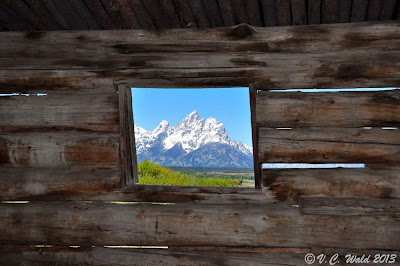I've blogged on the subject of "parkitecture" both in the context of
founding mother "parkitect" Mary Colter, and the wonderful
Parkitecture Flickr group (now up to 192 members and 1,982 exemplary photos I might add) to which people post their images of endearing man-made structures -- historic,
pre-historic, and contemporary -- that add to the aesthetics, function, and appeal of our national (and other) parks and public spaces.
Yellowstone and Grand Teton National Parks are both especially replete with such buildings and structures. This year, for example, we stopped by the historic
Cunningham Cabin in GTNP:
The Cunninghams settled in the area in the 1880s, toughing out baking summers and long, cold and snowy winters on the sage flats of Jackson Hole; the soil is poor, and water unreliable. Indeed it was drought that finally did in their enterprise. Now all that remains of the homestead ranch is this "double pen" style cabin, but oh my, without question, the view is still beyond compare.
Among GTNP's many other very old structures is the White Grass Dude Ranch, a mile or two up the stony, rutted, alternately dusty and gummy-mud road to Death Canyon trailhead. I first came upon White Grass in 2006, when the buildings were barely still upright and the marmots made homes in the cabins, emerging through holes in the roofs to safely check on interlopers (me).
That day I was the only person wandering around the stunningly beautiful "park" (wide open flat area), and there was no information, either on site or on the internet, to clue me in as to what I'd stumbled upon. Flash forward to 2013, now with an informative sign near the side of the road and heartening progress towards preservation:
A homestead of about the same era as Cunningham's,
White Grass Ranch first accommodated paying guests -- tourists to be sure -- in 1919. Though sold to the National Park Service in 1956, its owner at the time continued to operate it for dudes until 1985. Mouldering and neglected for the next 20 years, finally now, as noted on the National Park Service's Grand Teton National Park website, "...the
National Park Service,
National Trust [for Historic Preservation], and the
Western Center for Historic Preservation seek to rehabilitate not only the thirteen remaining cabins, but the cultural landscape as well." But it's even better than that: the prime mover in the project, the Western Center for Historic Preservation, is "...an
education and resource center dedicated to the preservation and
maintenance of cultural resources in our Western national parks. The
center promotes leadership in preservation education and skills
development with government partners, non-profits and educational
institutions committed to the same goals." The project at White Grass is a working laboratory that trains volunteers and National Park Service personnel in the conservation and restoration of historic structures. Once completed (2016, if all goes well) it will continue to be used as a training facility for what I consider to be one of the most worthy of possible goals of the National Park Service, the preservation and rehabilitation of historic and rustic buildings. Next year when we go back I'll have updates.
Grand Teton Park also has several contemporary, and equally significant structures; I've previously blogged about the newest, the
Laurance S. Rockefeller Preserve Center. Notable among other very recent GTNP builds is the
Craig Thomas Discovery and Visitor Center at Moose, Wyoming, which opened just inside the main entrance to the park in 2007. Designed by architectural firm of Bohlin, Cywinski Jackson, it represents quintessential 21st century parkitecture in its visually successful resonance with its natural the environment, the backdrop of the Grand Teton range. This is the inspiration the designers had to work with, as viewed from the visitor center parking lot:
And how they echoed it in the roof-line from the Japanese-style-like front entrance:
And how it looks from the opposite site (mountains to my back):
And what visitors see from the inside as they stroll through the educational exhibits on the geology, wildlife, and cultural history of Grand Teton National Park:














Interesting. Still most anything with a view of the Tetons is likely to be inspiring. Thanks Mr. Rockefeller....:)
ReplyDelete